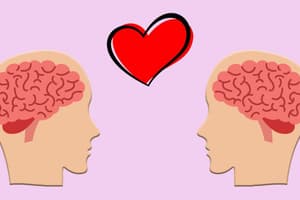Podcast
Questions and Answers
What is altruism?
What is altruism?
Unselfish regard for the welfare of others.
What is the bystander effect?
What is the bystander effect?
The tendency for any given bystander to be less likely to give aid if other bystanders are present.
What factors increase the likelihood of helping someone?
What factors increase the likelihood of helping someone?
When the person appears to need help, is similar to us, is a woman, when we observed someone else being helpful, when we are not in a hurry, in a small town, feeling guilty, focused on others, and in a good mood.
What does happiness breed?
What does happiness breed?
What is social exchange theory?
What is social exchange theory?
What is reciprocity norm?
What is reciprocity norm?
What is the social-responsibility norm?
What is the social-responsibility norm?
What is conflict?
What is conflict?
What is social trap?
What is social trap?
What has social trap challenged us to find?
What has social trap challenged us to find?
What are mirror-image perceptions?
What are mirror-image perceptions?
What is a self-fulfilling prophecy?
What is a self-fulfilling prophecy?
Does it help to put two conflicting parties into close contact?
Does it help to put two conflicting parties into close contact?
What are superordinate goals?
What are superordinate goals?
What is GRIT?
What is GRIT?
When are people most likely to help?
When are people most likely to help?
How do social exchange theory and social norms explain helping behavior?
How do social exchange theory and social norms explain helping behavior?
How do social traps and mirror-image perceptions fuel social conflict?
How do social traps and mirror-image perceptions fuel social conflict?
How can we transform feelings of prejudice, aggression, and conflict into attitudes that promote peace?
How can we transform feelings of prejudice, aggression, and conflict into attitudes that promote peace?
Which of the following is the best term or phrase for the unselfish concern for the welfare of others?
Which of the following is the best term or phrase for the unselfish concern for the welfare of others?
Which of the following maintains that our social behavior is an exchange process that minimizes costs?
Which of the following maintains that our social behavior is an exchange process that minimizes costs?
What do we call a situation in which the conflicting parties, by rationally pursuing their self-interest, become caught in mutually destructive behavior?
What do we call a situation in which the conflicting parties, by rationally pursuing their self-interest, become caught in mutually destructive behavior?
What do we call a belief that leads to its own fulfillment?
What do we call a belief that leads to its own fulfillment?
According to Darley and Latané, what three things must happen for a bystander to intervene?
According to Darley and Latané, what three things must happen for a bystander to intervene?
What are the two 'enemy perceptions' identified by the author?
What are the two 'enemy perceptions' identified by the author?
Flashcards are hidden until you start studying
Study Notes
Altruism
- Defined as unselfish regard for the welfare of others, involving actions like volunteering or donating without personal gain.
Bystander Effect
- Indicates that individuals are less likely to offer help in emergencies when others are present, counterintuitive to common expectations.
Factors Influencing Helping Behavior
- Helping is more likely when:
- The person appears to need and deserve assistance.
- The victim is similar to the helper.
- The victim is female.
- The helper has witnessed others being helpful.
- The helper is not in a hurry.
- The incident occurs in a rural area.
- The helper feels guilty.
- The helper is in a positive mood.
Happiness and Helpfulness
- There is a reciprocal relationship: happiness promotes helpful behavior, which in turn fosters more happiness.
Social Exchange Theory
- Proposes that people help when the perceived benefits outweigh the costs, focusing on maximizing rewards and minimizing disadvantages.
Reciprocity Norm
- Reflects the expectation that individuals will respond with help to those who have helped them, fostering mutual assistance.
Social-Responsibility Norm
- Suggests a moral obligation to assist those who need help, particularly vulnerable individuals like children.
Conflict
- Defined as a perceived incompatibility in actions, goals, or ideas between individuals or groups.
Social Trap
- Refers to situations where short-term solutions lead to long-term detrimental effects, such as environmental degradation due to overexploitation.
Balancing Personal and Collective Well-being
- Social traps encourage the need for cooperation and awareness of mutual responsibilities to enhance community welfare.
Mirror-Image Perceptions
- Arise in conflicts where each side views itself as ethical and peaceful while seeing the opponent as evil and aggressive.
Self-Fulfilling Prophecy
- A prediction that comes true simply because it was made, often due to biased actions responding to the belief.
Contact and Conflict Resolution
- Close contact between conflicting parties can be beneficial if it is noncompetitive and involves equal status individuals.
Superordinate Goals
- Shared objectives that require cooperation to achieve, helping bridge differences and foster collaboration among opposing groups.
GRIT Strategy
- Emphasizes initiating small, conciliatory acts to reduce tension between conflicting parties while maintaining strength.
Factors Affecting Helping Behavior Review
- Help is most likely when one notices an incident, interprets it as an emergency, and feels responsible. Presence of other bystanders can impede help (bystander effect).
Social Exchange Theory vs. Social Norms
- Social exchange theory emphasizes self-interest in helping behaviors, whereas social norms recognize learned social responsibilities like reciprocity and social responsibility.
Social Conflict Dynamics
- Social traps and mirror-image perceptions intensify conflicts by fostering distrust and harmful self-interest among parties.
Promoting Peace
- Peace is achievable through collective efforts toward superordinate goals, enhanced by processes of contact, cooperation, communication, and conciliation.
Studying That Suits You
Use AI to generate personalized quizzes and flashcards to suit your learning preferences.




